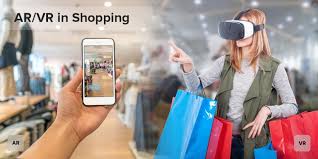The Future of Online Shopping: From AR to Personalization
As we navigate this ever-changing digital landscape, it's crucial for retailers to embrace these trends and provide customers with unforgettable experiences. The future of online shopping is here, and it's time to embrace it.
NixFrontier Group
4/2/20242 min read


The Future of Online Shopping: From AR to Personalization
Step into the world of tomorrow and get ready for a shopping experience like no other. The year is 2024, and the possibilities seem endless. Today, we explore two groundbreaking trends that are reshaping the landscape of online retail - Augmented Reality (AR) shopping and the power of personalization driven by Artificial Intelligence (AI).
Augmented Reality (AR) Shopping: Bringing the Store to Your Screen
Imagine being able to try on accessories like glasses, watches, hats, and jewelry without leaving the comfort of your home. With AR, this is now a reality. AR technology allows customers to envision products in a real-life environment, integrating orientation, direction, 3D modeling, and illustration with appropriate lighting conditions.
Gone are the days of traditional fitting rooms in brick-and-mortar stores. AR is taking over, providing customers with a virtual try-on experience. Retailers are also embracing AR in their advertising campaigns on social media platforms like Facebook and Instagram. Users can now try new products and see how they would look on them before making a purchase.
This immersive shopping experience not only engages customers but also offers a better understanding of the product, akin to seeing it in a physical store. By providing a more realistic sense of the product, AR shopping may result in fewer returns, saving retailers both time and money.
Personalization & AI: Your Shopping Experience, Tailored Just for You
In the era of e-commerce, personalization is king. Customers are more likely to spend money and remain loyal to brands that understand their preferences and needs. To stand out from the competition and build a strong brand identity, online retailers must embrace personalization.
According to McKinsey, a staggering 71% of consumers expect personalization, and 76% feel frustrated when it's absent. But what does personalization mean in the world of online shopping?
It starts with relevant recommendations based on customers' browsing history. Have you ever left an item in your cart and received a gentle reminder? That's personalized marketing in action. By tailoring product suggestions to individual preferences, retailers can create a more engaging experience and build a deeper connection with their customers.
Hyper-segmentation takes personalization to the next level. By dividing the customer base into niche groups, retailers can send the most relevant content and build more meaningful interactions. It's all about understanding the unique needs and desires of each customer and delivering a shopping experience that feels tailor-made.
But how do retailers manage to personalize at such scale? Enter Artificial Intelligence (AI). AI algorithms filter through vast amounts of data to build detailed customer profiles. These profiles are then used to tailor e-commerce strategies and provide personalized recommendations. Chatbots powered by generative AI can assist customers by suggesting products based on their shopping behavior and preferences.
However, it's important to find the right balance when it comes to personalization. Retailers must be mindful of being helpful without being intrusive. Walking this fine line is crucial to ensure that customers feel understood and valued without feeling overwhelmed.
The Future is Here
The future of online shopping is now, and it's filled with exciting possibilities. Augmented Reality (AR) shopping brings the store to your screen, allowing you to try on products virtually. Personalization driven by AI takes your shopping experience to new heights, tailoring recommendations and interactions to your unique preferences.
As we navigate this ever-changing digital landscape, it's crucial for retailers to embrace these trends and provide customers with unforgettable experiences. The future of online shopping is here, and it's time to embrace it.


